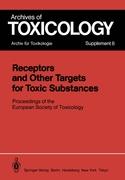- Start
- Receptors and Other Targets for Toxic Substances
Receptors and Other Targets for Toxic Substances
Angebote / Angebote:
Trichloroethylene (TRI), administered orally at high doses for 18 months has been shown to increase the incidence of hepatocellular carcinoma in B6C3F 1 mice but not Osborne-Mendel rats (NCI, 1976). The interpretation of these studies has been confounded due to the presence of epoxide stabilizers in the TRI. However more recent studies have demonstrated that pure TRI also causes hepatocellular carcinoma in B6C3F mice (NTP, 1983) and Aldedey Park (Swiss) mice (Elcombe 1 and Pratt, unpublished data). Furthermore, no increase in the incidence of hepatocellular carcinoma was observed in Fisher 344 rats administered pure TRI (NTP, 1983). TRI has been extensively examined for mutagenic potential, but many studies were bedeviled by the presence of mutagenic epoxide stabilizers. However, in general, TRI has been found to be only 'marginally' mutagenic or non-mutagenic (Greim et ai., 1975, Simmon et ai., 1977, Bronzetti et ai., 1978, Waskell, 1978, Bartsch et ai., 1979, Slacik-Erben et ai., 1980). Covalent binding of trichloroethylene or its metabolites to protein, RNA and DNA has been illustrated in vitro (Van Duuren and Banerjee, 1976, Bolt et ai., 1977, Bolt and Filser, 1977, Uehleke and Poplawski-Tabarelli, 1977, Banerjee and Van Dauren, 1978). However, in vivo, only extremely low (indistinguishable from protein binding) or zero binding of TRI metabolites to DNA has been reported (Parchman and Magee, 1982, Stott et ai., 1982).
Folgt in ca. 5 Arbeitstagen




